Marketing Principles: Analysis of ALDI's Marketing Strategies
VerifiedAdded on 2020/10/05
|14
|3944
|485
Report
AI Summary
This report provides a comprehensive analysis of marketing principles through a case study of ALDI, a retail company. It begins by outlining the marketing process, including analyzing opportunities, evaluating target markets, and making strategic decisions within the marketing mix. The report then assesses the benefits and costs of a marketing orientation, focusing on customer centricity and competitive advancement. It delves into the macro and micro environmental factors influencing ALDI's decisions, followed by an examination of segmentation criteria (demographic, geographic, behavioral, and psychographic) and targeting strategies (differentiated, undifferentiated, and concentrated). The impact of buyer behavior, including habitual and dissonance behavior, on marketing activities is also discussed. The report further explores product positioning, competitive advantages (cost leadership, differentiation, and focus), distribution channels, and pricing strategies. Overall, the report offers valuable insights into ALDI's marketing approach and its application of core marketing principles to achieve competitive advantage and customer satisfaction.
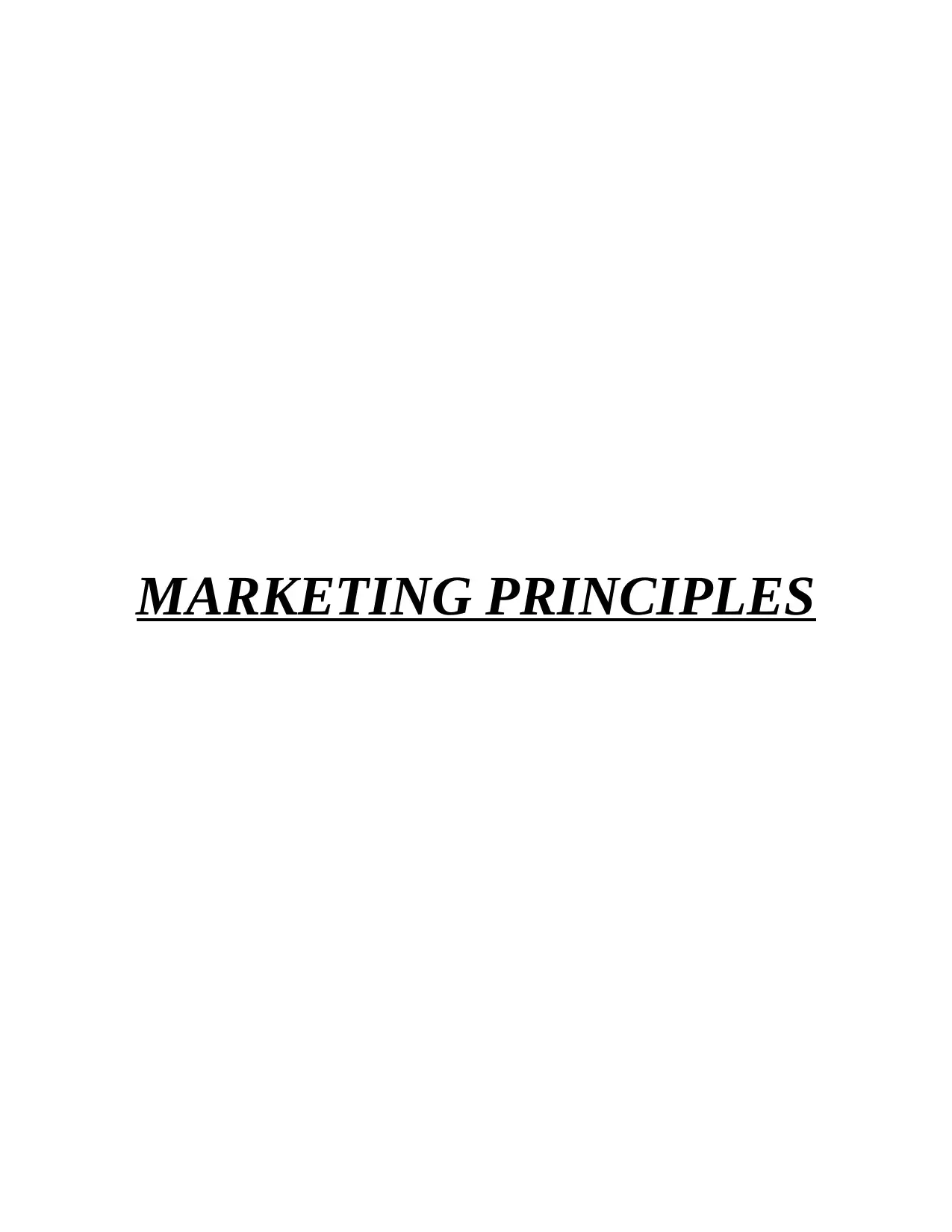
MARKETING PRINCIPLES
Paraphrase This Document
Need a fresh take? Get an instant paraphrase of this document with our AI Paraphraser

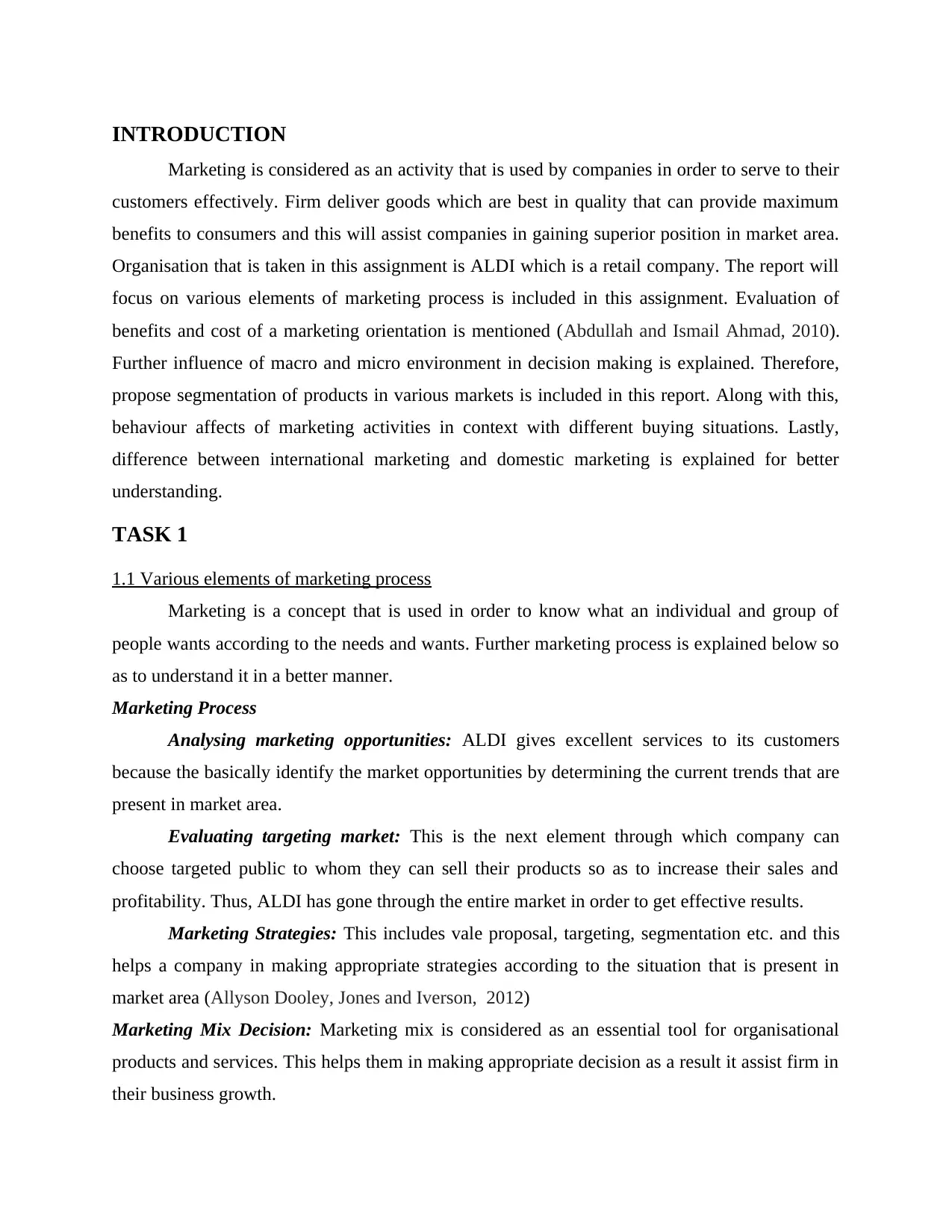
INTRODUCTION
Marketing is considered as an activity that is used by companies in order to serve to their
customers effectively. Firm deliver goods which are best in quality that can provide maximum
benefits to consumers and this will assist companies in gaining superior position in market area.
Organisation that is taken in this assignment is ALDI which is a retail company. The report will
focus on various elements of marketing process is included in this assignment. Evaluation of
benefits and cost of a marketing orientation is mentioned (Abdullah and Ismail Ahmad, 2010).
Further influence of macro and micro environment in decision making is explained. Therefore,
propose segmentation of products in various markets is included in this report. Along with this,
behaviour affects of marketing activities in context with different buying situations. Lastly,
difference between international marketing and domestic marketing is explained for better
understanding.
TASK 1
1.1 Various elements of marketing process
Marketing is a concept that is used in order to know what an individual and group of
people wants according to the needs and wants. Further marketing process is explained below so
as to understand it in a better manner.
Marketing Process
Analysing marketing opportunities: ALDI gives excellent services to its customers
because the basically identify the market opportunities by determining the current trends that are
present in market area.
Evaluating targeting market: This is the next element through which company can
choose targeted public to whom they can sell their products so as to increase their sales and
profitability. Thus, ALDI has gone through the entire market in order to get effective results.
Marketing Strategies: This includes vale proposal, targeting, segmentation etc. and this
helps a company in making appropriate strategies according to the situation that is present in
market area (Allyson Dooley, Jones and Iverson, 2012)
Marketing Mix Decision: Marketing mix is considered as an essential tool for organisational
products and services. This helps them in making appropriate decision as a result it assist firm in
their business growth.
Marketing is considered as an activity that is used by companies in order to serve to their
customers effectively. Firm deliver goods which are best in quality that can provide maximum
benefits to consumers and this will assist companies in gaining superior position in market area.
Organisation that is taken in this assignment is ALDI which is a retail company. The report will
focus on various elements of marketing process is included in this assignment. Evaluation of
benefits and cost of a marketing orientation is mentioned (Abdullah and Ismail Ahmad, 2010).
Further influence of macro and micro environment in decision making is explained. Therefore,
propose segmentation of products in various markets is included in this report. Along with this,
behaviour affects of marketing activities in context with different buying situations. Lastly,
difference between international marketing and domestic marketing is explained for better
understanding.
TASK 1
1.1 Various elements of marketing process
Marketing is a concept that is used in order to know what an individual and group of
people wants according to the needs and wants. Further marketing process is explained below so
as to understand it in a better manner.
Marketing Process
Analysing marketing opportunities: ALDI gives excellent services to its customers
because the basically identify the market opportunities by determining the current trends that are
present in market area.
Evaluating targeting market: This is the next element through which company can
choose targeted public to whom they can sell their products so as to increase their sales and
profitability. Thus, ALDI has gone through the entire market in order to get effective results.
Marketing Strategies: This includes vale proposal, targeting, segmentation etc. and this
helps a company in making appropriate strategies according to the situation that is present in
market area (Allyson Dooley, Jones and Iverson, 2012)
Marketing Mix Decision: Marketing mix is considered as an essential tool for organisational
products and services. This helps them in making appropriate decision as a result it assist firm in
their business growth.
⊘ This is a preview!⊘
Do you want full access?
Subscribe today to unlock all pages.

Trusted by 1+ million students worldwide
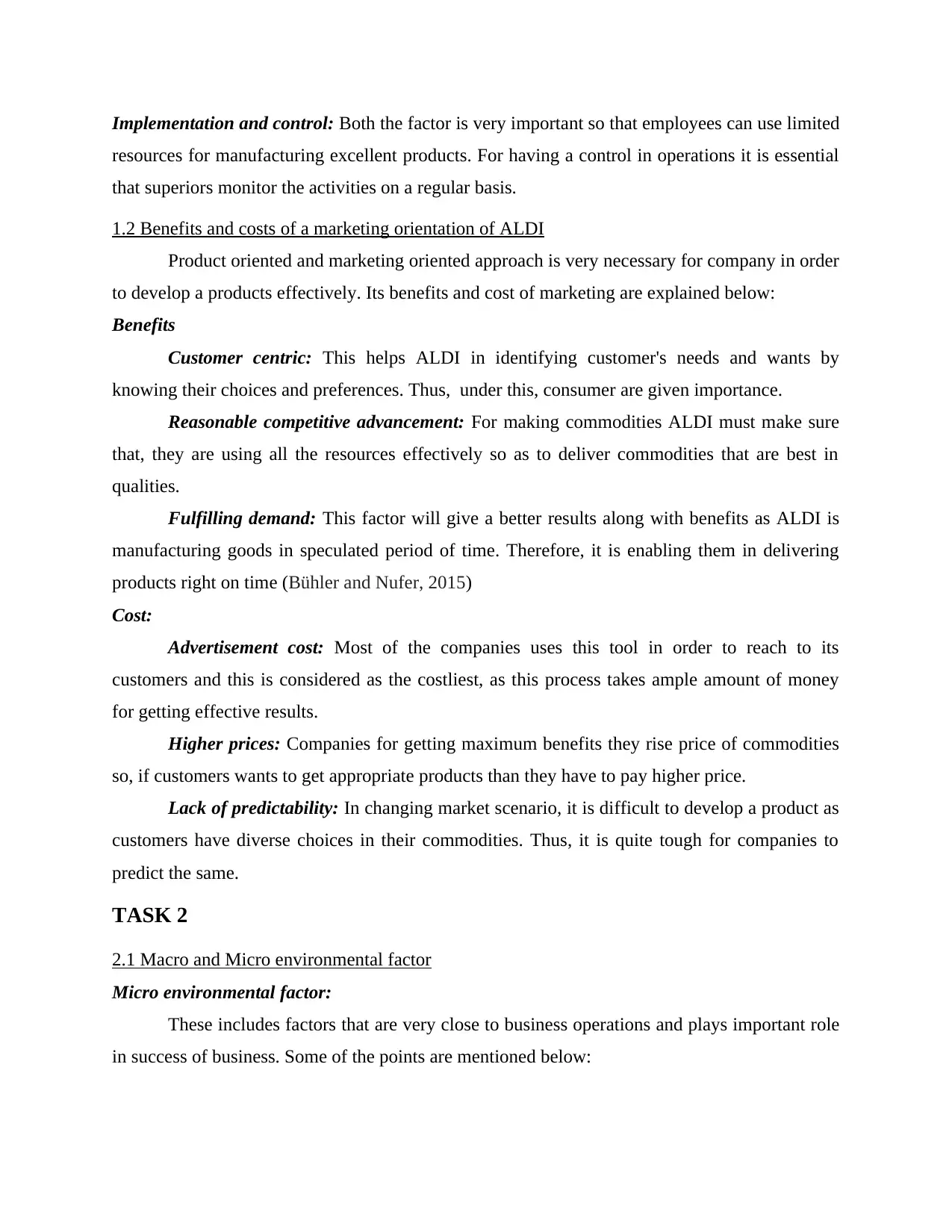
Implementation and control: Both the factor is very important so that employees can use limited
resources for manufacturing excellent products. For having a control in operations it is essential
that superiors monitor the activities on a regular basis.
1.2 Benefits and costs of a marketing orientation of ALDI
Product oriented and marketing oriented approach is very necessary for company in order
to develop a products effectively. Its benefits and cost of marketing are explained below:
Benefits
Customer centric: This helps ALDI in identifying customer's needs and wants by
knowing their choices and preferences. Thus, under this, consumer are given importance.
Reasonable competitive advancement: For making commodities ALDI must make sure
that, they are using all the resources effectively so as to deliver commodities that are best in
qualities.
Fulfilling demand: This factor will give a better results along with benefits as ALDI is
manufacturing goods in speculated period of time. Therefore, it is enabling them in delivering
products right on time (Bühler and Nufer, 2015)
Cost:
Advertisement cost: Most of the companies uses this tool in order to reach to its
customers and this is considered as the costliest, as this process takes ample amount of money
for getting effective results.
Higher prices: Companies for getting maximum benefits they rise price of commodities
so, if customers wants to get appropriate products than they have to pay higher price.
Lack of predictability: In changing market scenario, it is difficult to develop a product as
customers have diverse choices in their commodities. Thus, it is quite tough for companies to
predict the same.
TASK 2
2.1 Macro and Micro environmental factor
Micro environmental factor:
These includes factors that are very close to business operations and plays important role
in success of business. Some of the points are mentioned below:
resources for manufacturing excellent products. For having a control in operations it is essential
that superiors monitor the activities on a regular basis.
1.2 Benefits and costs of a marketing orientation of ALDI
Product oriented and marketing oriented approach is very necessary for company in order
to develop a products effectively. Its benefits and cost of marketing are explained below:
Benefits
Customer centric: This helps ALDI in identifying customer's needs and wants by
knowing their choices and preferences. Thus, under this, consumer are given importance.
Reasonable competitive advancement: For making commodities ALDI must make sure
that, they are using all the resources effectively so as to deliver commodities that are best in
qualities.
Fulfilling demand: This factor will give a better results along with benefits as ALDI is
manufacturing goods in speculated period of time. Therefore, it is enabling them in delivering
products right on time (Bühler and Nufer, 2015)
Cost:
Advertisement cost: Most of the companies uses this tool in order to reach to its
customers and this is considered as the costliest, as this process takes ample amount of money
for getting effective results.
Higher prices: Companies for getting maximum benefits they rise price of commodities
so, if customers wants to get appropriate products than they have to pay higher price.
Lack of predictability: In changing market scenario, it is difficult to develop a product as
customers have diverse choices in their commodities. Thus, it is quite tough for companies to
predict the same.
TASK 2
2.1 Macro and Micro environmental factor
Micro environmental factor:
These includes factors that are very close to business operations and plays important role
in success of business. Some of the points are mentioned below:
Paraphrase This Document
Need a fresh take? Get an instant paraphrase of this document with our AI Paraphraser

Customers: ALDI is manufacturing goods according to the customers satisfaction hence,
it is helping them in retaining consumers loyalty.
Employees: They are determined as a key element who work for company so as to
provide benefits to respective organisation.
Macro Environment Factor:
Demographic Factors: This factor must be determined by companies before establishing
any product and it includes occupation, age, sex, density and location. This will give company an
overview from where they can get maximum benefits.
Economic environment: This includes the capabilities of buying and selling process by a
person.
Natural environment: This consist of elements such as natural resources, raw materials
etc. as these can have a great impact on business operations as it will assist company in
manufacturing best quality goods.
Technological factor: All the latest tools and technologies are included in this macro
environmental factor (Challagalla, Murtha and Jaworski, 2014).
Political factor: Rules and regulations made by regulatory bodies at national and
international level. This help companies in regulating the task in an effective manner.
2.2 Segmentation criteria for making products different in market
ALDI is giving a wide range of options to its customers so for this they have divided the
entire market into segments and different parts. Therefore, some of the segments are mentioned
below:
Demographical Segmentation: This segment majorly focused on population and people
living in these areas. This also includes factors like race, class, status, income of people and
many more.
Geographical Segmentation: ALDI has divided this segment on the basis of size and
climatic condition of a particular places and they are manufacturing goods accordingly.
Behavioural Segmentation: Nature of person must also be considered as this will assist
firm in analysing the choices and preferences of customers. If consumers will not get appropriate
results than company's growth can be hampered.
Psychographic Segmentation: Under this, all the choices and preferences are considered
and in context with ALDI they are manufacturing goods as per the choices and preferences so
it is helping them in retaining consumers loyalty.
Employees: They are determined as a key element who work for company so as to
provide benefits to respective organisation.
Macro Environment Factor:
Demographic Factors: This factor must be determined by companies before establishing
any product and it includes occupation, age, sex, density and location. This will give company an
overview from where they can get maximum benefits.
Economic environment: This includes the capabilities of buying and selling process by a
person.
Natural environment: This consist of elements such as natural resources, raw materials
etc. as these can have a great impact on business operations as it will assist company in
manufacturing best quality goods.
Technological factor: All the latest tools and technologies are included in this macro
environmental factor (Challagalla, Murtha and Jaworski, 2014).
Political factor: Rules and regulations made by regulatory bodies at national and
international level. This help companies in regulating the task in an effective manner.
2.2 Segmentation criteria for making products different in market
ALDI is giving a wide range of options to its customers so for this they have divided the
entire market into segments and different parts. Therefore, some of the segments are mentioned
below:
Demographical Segmentation: This segment majorly focused on population and people
living in these areas. This also includes factors like race, class, status, income of people and
many more.
Geographical Segmentation: ALDI has divided this segment on the basis of size and
climatic condition of a particular places and they are manufacturing goods accordingly.
Behavioural Segmentation: Nature of person must also be considered as this will assist
firm in analysing the choices and preferences of customers. If consumers will not get appropriate
results than company's growth can be hampered.
Psychographic Segmentation: Under this, all the choices and preferences are considered
and in context with ALDI they are manufacturing goods as per the choices and preferences so
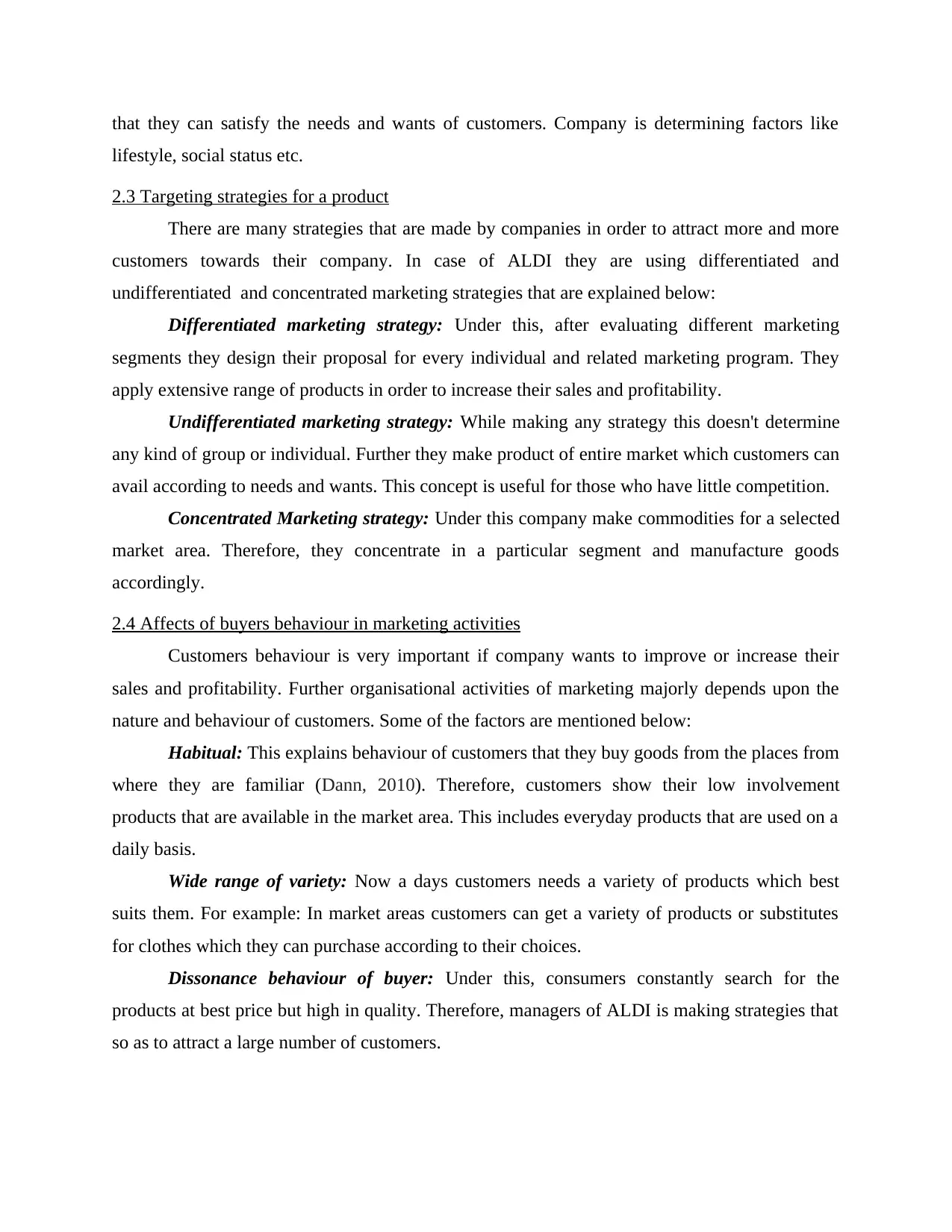
that they can satisfy the needs and wants of customers. Company is determining factors like
lifestyle, social status etc.
2.3 Targeting strategies for a product
There are many strategies that are made by companies in order to attract more and more
customers towards their company. In case of ALDI they are using differentiated and
undifferentiated and concentrated marketing strategies that are explained below:
Differentiated marketing strategy: Under this, after evaluating different marketing
segments they design their proposal for every individual and related marketing program. They
apply extensive range of products in order to increase their sales and profitability.
Undifferentiated marketing strategy: While making any strategy this doesn't determine
any kind of group or individual. Further they make product of entire market which customers can
avail according to needs and wants. This concept is useful for those who have little competition.
Concentrated Marketing strategy: Under this company make commodities for a selected
market area. Therefore, they concentrate in a particular segment and manufacture goods
accordingly.
2.4 Affects of buyers behaviour in marketing activities
Customers behaviour is very important if company wants to improve or increase their
sales and profitability. Further organisational activities of marketing majorly depends upon the
nature and behaviour of customers. Some of the factors are mentioned below:
Habitual: This explains behaviour of customers that they buy goods from the places from
where they are familiar (Dann, 2010). Therefore, customers show their low involvement
products that are available in the market area. This includes everyday products that are used on a
daily basis.
Wide range of variety: Now a days customers needs a variety of products which best
suits them. For example: In market areas customers can get a variety of products or substitutes
for clothes which they can purchase according to their choices.
Dissonance behaviour of buyer: Under this, consumers constantly search for the
products at best price but high in quality. Therefore, managers of ALDI is making strategies that
so as to attract a large number of customers.
lifestyle, social status etc.
2.3 Targeting strategies for a product
There are many strategies that are made by companies in order to attract more and more
customers towards their company. In case of ALDI they are using differentiated and
undifferentiated and concentrated marketing strategies that are explained below:
Differentiated marketing strategy: Under this, after evaluating different marketing
segments they design their proposal for every individual and related marketing program. They
apply extensive range of products in order to increase their sales and profitability.
Undifferentiated marketing strategy: While making any strategy this doesn't determine
any kind of group or individual. Further they make product of entire market which customers can
avail according to needs and wants. This concept is useful for those who have little competition.
Concentrated Marketing strategy: Under this company make commodities for a selected
market area. Therefore, they concentrate in a particular segment and manufacture goods
accordingly.
2.4 Affects of buyers behaviour in marketing activities
Customers behaviour is very important if company wants to improve or increase their
sales and profitability. Further organisational activities of marketing majorly depends upon the
nature and behaviour of customers. Some of the factors are mentioned below:
Habitual: This explains behaviour of customers that they buy goods from the places from
where they are familiar (Dann, 2010). Therefore, customers show their low involvement
products that are available in the market area. This includes everyday products that are used on a
daily basis.
Wide range of variety: Now a days customers needs a variety of products which best
suits them. For example: In market areas customers can get a variety of products or substitutes
for clothes which they can purchase according to their choices.
Dissonance behaviour of buyer: Under this, consumers constantly search for the
products at best price but high in quality. Therefore, managers of ALDI is making strategies that
so as to attract a large number of customers.
⊘ This is a preview!⊘
Do you want full access?
Subscribe today to unlock all pages.

Trusted by 1+ million students worldwide

Henceforth, ALDI is also determining the cultural and social factors while manufacturing
their products and commodities. For example: Company is making and designing clothes that are
according to the latest trends.
2.5 Propose of new positioning of a product
Positioning is consist of measures through which they target the minds of customers in
order to increase their sales and profitability. Further this can be classified into 3 steps i.e. to
uncover competitive advancement so as to know positioning, for choosing the correct
competitive advancement for determining the position and lastly, through excellent
communicating tools. Henceforth, it is explained below:
Positioning by benefits: Manufacturing goods according to the needs and wants of
customers is the only task what important is whether will provide benefits to customers or not.
This will help organisation in sustaining a better position at market area.
Positioning by quality: As ALDI is producing goods that are excellent by their quality
and people prefer to purchase goods from there. For example: for manufacturing clothes they are
using best quality fabrics as a result it is assisting them in gaining maximum benefits.
Positioning by user: This is evaluated after consumers used a particular products, if these
are according to needs and wants of customers than product will gain a superior position at
market area (Deshpande and Rundle-Thiele, 2011)
Positioning by category: There are many products that are manufactured by the
companies in order to increase the sales and profitability. For example:household products
manufactured by ALDI are given highest ratings as per their quality and category.
TASK 3
3.1 Products and development for competitive advancement
With the rapid change in choice and taste of customers it is quite difficult for them in
manufacture goods according to the current market trends. For making a product it go through
certain steps i.e. idea screening, concept development and testing, business analysis, market
testing, technical implementation, commercialisation and product pricing.
Along with this, for gaining competitive advancement there are certain points that
company must consider for sustaining a better position at market area.
their products and commodities. For example: Company is making and designing clothes that are
according to the latest trends.
2.5 Propose of new positioning of a product
Positioning is consist of measures through which they target the minds of customers in
order to increase their sales and profitability. Further this can be classified into 3 steps i.e. to
uncover competitive advancement so as to know positioning, for choosing the correct
competitive advancement for determining the position and lastly, through excellent
communicating tools. Henceforth, it is explained below:
Positioning by benefits: Manufacturing goods according to the needs and wants of
customers is the only task what important is whether will provide benefits to customers or not.
This will help organisation in sustaining a better position at market area.
Positioning by quality: As ALDI is producing goods that are excellent by their quality
and people prefer to purchase goods from there. For example: for manufacturing clothes they are
using best quality fabrics as a result it is assisting them in gaining maximum benefits.
Positioning by user: This is evaluated after consumers used a particular products, if these
are according to needs and wants of customers than product will gain a superior position at
market area (Deshpande and Rundle-Thiele, 2011)
Positioning by category: There are many products that are manufactured by the
companies in order to increase the sales and profitability. For example:household products
manufactured by ALDI are given highest ratings as per their quality and category.
TASK 3
3.1 Products and development for competitive advancement
With the rapid change in choice and taste of customers it is quite difficult for them in
manufacture goods according to the current market trends. For making a product it go through
certain steps i.e. idea screening, concept development and testing, business analysis, market
testing, technical implementation, commercialisation and product pricing.
Along with this, for gaining competitive advancement there are certain points that
company must consider for sustaining a better position at market area.
Paraphrase This Document
Need a fresh take? Get an instant paraphrase of this document with our AI Paraphraser
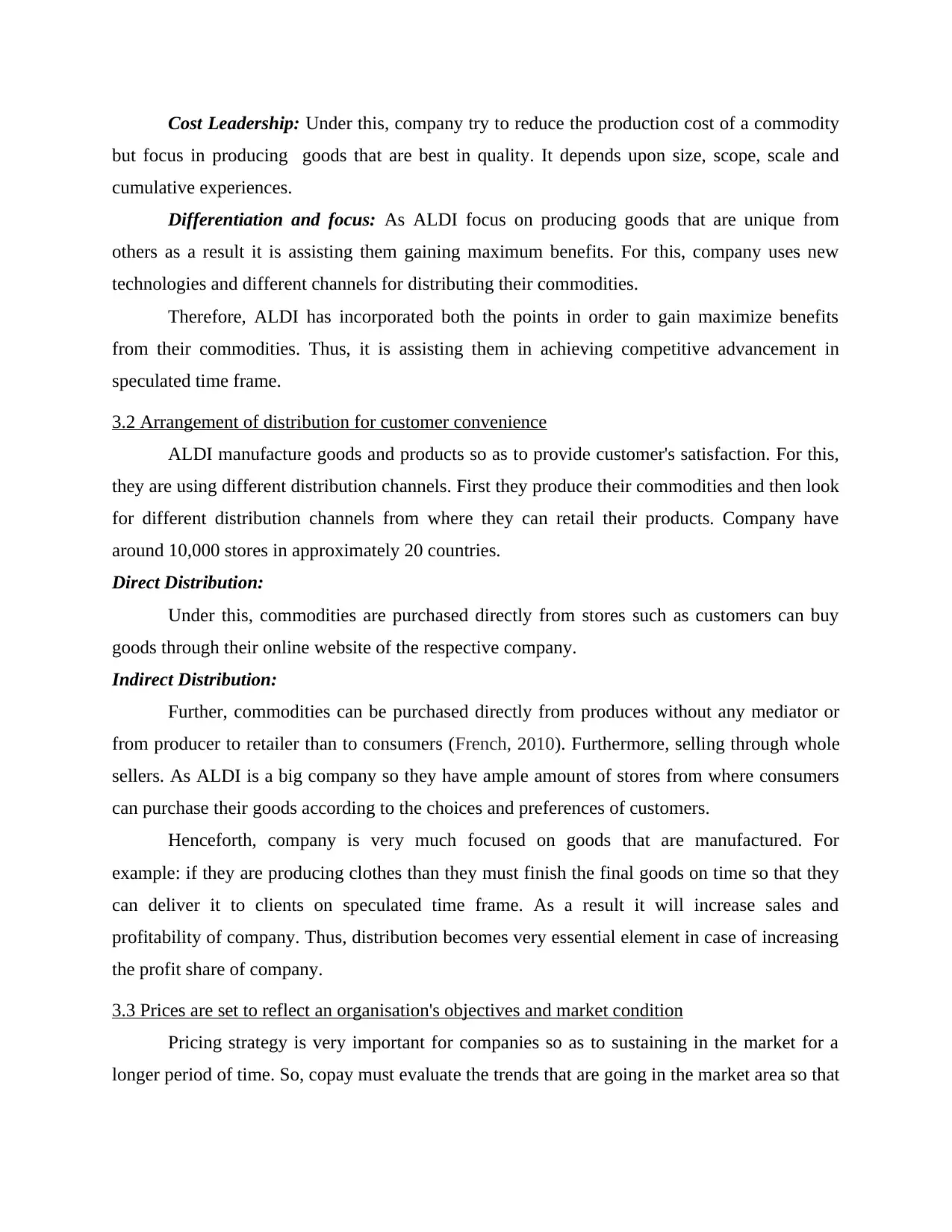
Cost Leadership: Under this, company try to reduce the production cost of a commodity
but focus in producing goods that are best in quality. It depends upon size, scope, scale and
cumulative experiences.
Differentiation and focus: As ALDI focus on producing goods that are unique from
others as a result it is assisting them gaining maximum benefits. For this, company uses new
technologies and different channels for distributing their commodities.
Therefore, ALDI has incorporated both the points in order to gain maximize benefits
from their commodities. Thus, it is assisting them in achieving competitive advancement in
speculated time frame.
3.2 Arrangement of distribution for customer convenience
ALDI manufacture goods and products so as to provide customer's satisfaction. For this,
they are using different distribution channels. First they produce their commodities and then look
for different distribution channels from where they can retail their products. Company have
around 10,000 stores in approximately 20 countries.
Direct Distribution:
Under this, commodities are purchased directly from stores such as customers can buy
goods through their online website of the respective company.
Indirect Distribution:
Further, commodities can be purchased directly from produces without any mediator or
from producer to retailer than to consumers (French, 2010). Furthermore, selling through whole
sellers. As ALDI is a big company so they have ample amount of stores from where consumers
can purchase their goods according to the choices and preferences of customers.
Henceforth, company is very much focused on goods that are manufactured. For
example: if they are producing clothes than they must finish the final goods on time so that they
can deliver it to clients on speculated time frame. As a result it will increase sales and
profitability of company. Thus, distribution becomes very essential element in case of increasing
the profit share of company.
3.3 Prices are set to reflect an organisation's objectives and market condition
Pricing strategy is very important for companies so as to sustaining in the market for a
longer period of time. So, copay must evaluate the trends that are going in the market area so that
but focus in producing goods that are best in quality. It depends upon size, scope, scale and
cumulative experiences.
Differentiation and focus: As ALDI focus on producing goods that are unique from
others as a result it is assisting them gaining maximum benefits. For this, company uses new
technologies and different channels for distributing their commodities.
Therefore, ALDI has incorporated both the points in order to gain maximize benefits
from their commodities. Thus, it is assisting them in achieving competitive advancement in
speculated time frame.
3.2 Arrangement of distribution for customer convenience
ALDI manufacture goods and products so as to provide customer's satisfaction. For this,
they are using different distribution channels. First they produce their commodities and then look
for different distribution channels from where they can retail their products. Company have
around 10,000 stores in approximately 20 countries.
Direct Distribution:
Under this, commodities are purchased directly from stores such as customers can buy
goods through their online website of the respective company.
Indirect Distribution:
Further, commodities can be purchased directly from produces without any mediator or
from producer to retailer than to consumers (French, 2010). Furthermore, selling through whole
sellers. As ALDI is a big company so they have ample amount of stores from where consumers
can purchase their goods according to the choices and preferences of customers.
Henceforth, company is very much focused on goods that are manufactured. For
example: if they are producing clothes than they must finish the final goods on time so that they
can deliver it to clients on speculated time frame. As a result it will increase sales and
profitability of company. Thus, distribution becomes very essential element in case of increasing
the profit share of company.
3.3 Prices are set to reflect an organisation's objectives and market condition
Pricing strategy is very important for companies so as to sustaining in the market for a
longer period of time. So, copay must evaluate the trends that are going in the market area so that
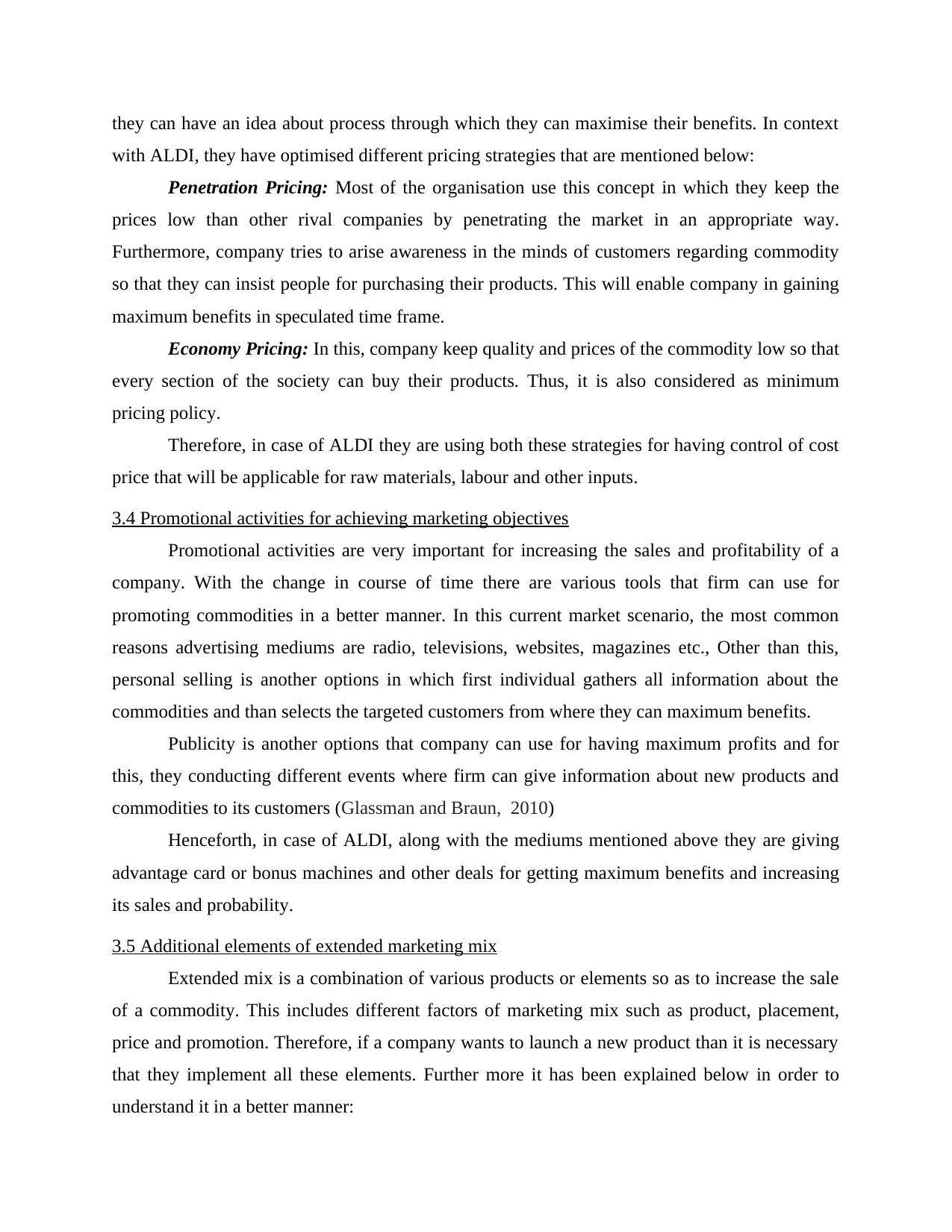
they can have an idea about process through which they can maximise their benefits. In context
with ALDI, they have optimised different pricing strategies that are mentioned below:
Penetration Pricing: Most of the organisation use this concept in which they keep the
prices low than other rival companies by penetrating the market in an appropriate way.
Furthermore, company tries to arise awareness in the minds of customers regarding commodity
so that they can insist people for purchasing their products. This will enable company in gaining
maximum benefits in speculated time frame.
Economy Pricing: In this, company keep quality and prices of the commodity low so that
every section of the society can buy their products. Thus, it is also considered as minimum
pricing policy.
Therefore, in case of ALDI they are using both these strategies for having control of cost
price that will be applicable for raw materials, labour and other inputs.
3.4 Promotional activities for achieving marketing objectives
Promotional activities are very important for increasing the sales and profitability of a
company. With the change in course of time there are various tools that firm can use for
promoting commodities in a better manner. In this current market scenario, the most common
reasons advertising mediums are radio, televisions, websites, magazines etc., Other than this,
personal selling is another options in which first individual gathers all information about the
commodities and than selects the targeted customers from where they can maximum benefits.
Publicity is another options that company can use for having maximum profits and for
this, they conducting different events where firm can give information about new products and
commodities to its customers (Glassman and Braun, 2010)
Henceforth, in case of ALDI, along with the mediums mentioned above they are giving
advantage card or bonus machines and other deals for getting maximum benefits and increasing
its sales and probability.
3.5 Additional elements of extended marketing mix
Extended mix is a combination of various products or elements so as to increase the sale
of a commodity. This includes different factors of marketing mix such as product, placement,
price and promotion. Therefore, if a company wants to launch a new product than it is necessary
that they implement all these elements. Further more it has been explained below in order to
understand it in a better manner:
with ALDI, they have optimised different pricing strategies that are mentioned below:
Penetration Pricing: Most of the organisation use this concept in which they keep the
prices low than other rival companies by penetrating the market in an appropriate way.
Furthermore, company tries to arise awareness in the minds of customers regarding commodity
so that they can insist people for purchasing their products. This will enable company in gaining
maximum benefits in speculated time frame.
Economy Pricing: In this, company keep quality and prices of the commodity low so that
every section of the society can buy their products. Thus, it is also considered as minimum
pricing policy.
Therefore, in case of ALDI they are using both these strategies for having control of cost
price that will be applicable for raw materials, labour and other inputs.
3.4 Promotional activities for achieving marketing objectives
Promotional activities are very important for increasing the sales and profitability of a
company. With the change in course of time there are various tools that firm can use for
promoting commodities in a better manner. In this current market scenario, the most common
reasons advertising mediums are radio, televisions, websites, magazines etc., Other than this,
personal selling is another options in which first individual gathers all information about the
commodities and than selects the targeted customers from where they can maximum benefits.
Publicity is another options that company can use for having maximum profits and for
this, they conducting different events where firm can give information about new products and
commodities to its customers (Glassman and Braun, 2010)
Henceforth, in case of ALDI, along with the mediums mentioned above they are giving
advantage card or bonus machines and other deals for getting maximum benefits and increasing
its sales and probability.
3.5 Additional elements of extended marketing mix
Extended mix is a combination of various products or elements so as to increase the sale
of a commodity. This includes different factors of marketing mix such as product, placement,
price and promotion. Therefore, if a company wants to launch a new product than it is necessary
that they implement all these elements. Further more it has been explained below in order to
understand it in a better manner:
⊘ This is a preview!⊘
Do you want full access?
Subscribe today to unlock all pages.

Trusted by 1+ million students worldwide
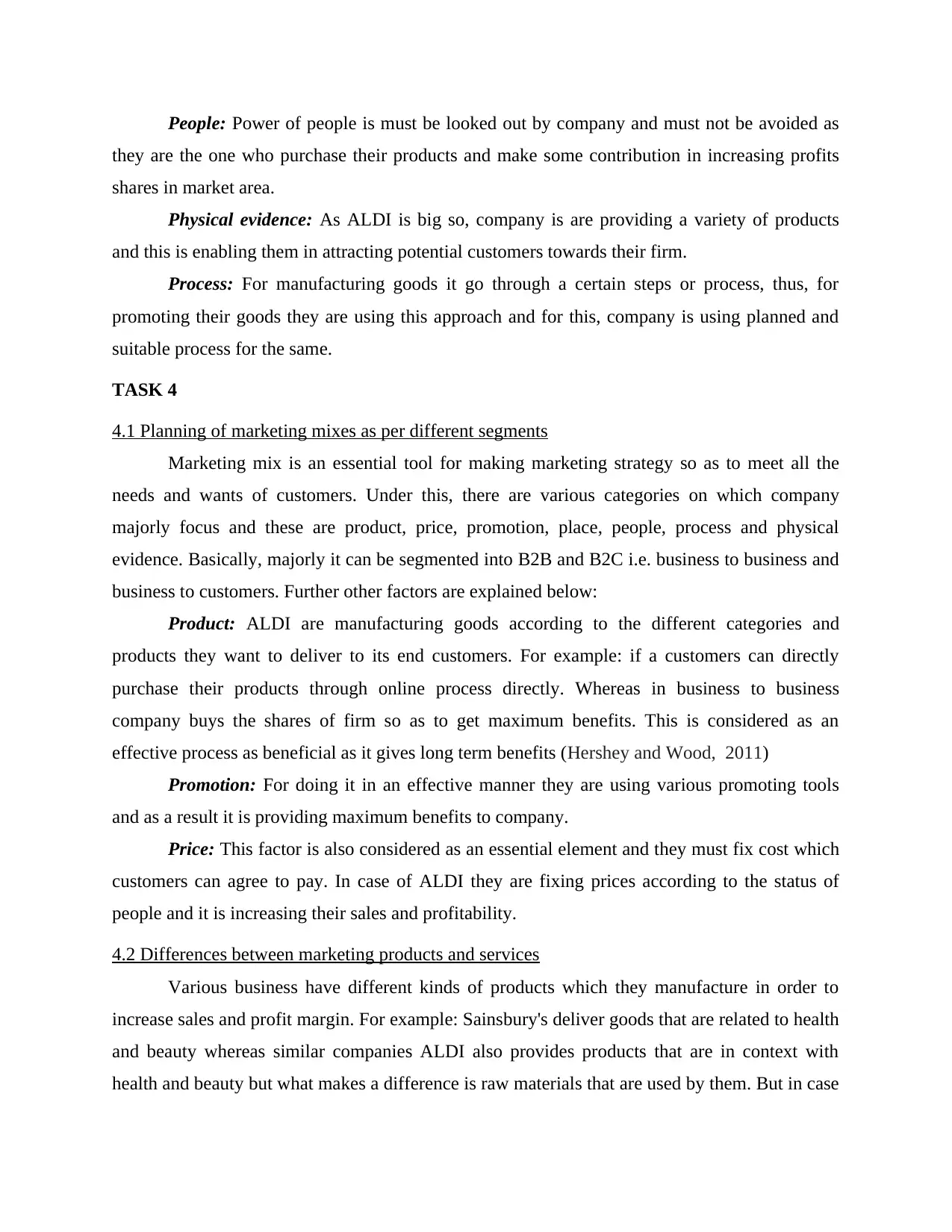
People: Power of people is must be looked out by company and must not be avoided as
they are the one who purchase their products and make some contribution in increasing profits
shares in market area.
Physical evidence: As ALDI is big so, company is are providing a variety of products
and this is enabling them in attracting potential customers towards their firm.
Process: For manufacturing goods it go through a certain steps or process, thus, for
promoting their goods they are using this approach and for this, company is using planned and
suitable process for the same.
TASK 4
4.1 Planning of marketing mixes as per different segments
Marketing mix is an essential tool for making marketing strategy so as to meet all the
needs and wants of customers. Under this, there are various categories on which company
majorly focus and these are product, price, promotion, place, people, process and physical
evidence. Basically, majorly it can be segmented into B2B and B2C i.e. business to business and
business to customers. Further other factors are explained below:
Product: ALDI are manufacturing goods according to the different categories and
products they want to deliver to its end customers. For example: if a customers can directly
purchase their products through online process directly. Whereas in business to business
company buys the shares of firm so as to get maximum benefits. This is considered as an
effective process as beneficial as it gives long term benefits (Hershey and Wood, 2011)
Promotion: For doing it in an effective manner they are using various promoting tools
and as a result it is providing maximum benefits to company.
Price: This factor is also considered as an essential element and they must fix cost which
customers can agree to pay. In case of ALDI they are fixing prices according to the status of
people and it is increasing their sales and profitability.
4.2 Differences between marketing products and services
Various business have different kinds of products which they manufacture in order to
increase sales and profit margin. For example: Sainsbury's deliver goods that are related to health
and beauty whereas similar companies ALDI also provides products that are in context with
health and beauty but what makes a difference is raw materials that are used by them. But in case
they are the one who purchase their products and make some contribution in increasing profits
shares in market area.
Physical evidence: As ALDI is big so, company is are providing a variety of products
and this is enabling them in attracting potential customers towards their firm.
Process: For manufacturing goods it go through a certain steps or process, thus, for
promoting their goods they are using this approach and for this, company is using planned and
suitable process for the same.
TASK 4
4.1 Planning of marketing mixes as per different segments
Marketing mix is an essential tool for making marketing strategy so as to meet all the
needs and wants of customers. Under this, there are various categories on which company
majorly focus and these are product, price, promotion, place, people, process and physical
evidence. Basically, majorly it can be segmented into B2B and B2C i.e. business to business and
business to customers. Further other factors are explained below:
Product: ALDI are manufacturing goods according to the different categories and
products they want to deliver to its end customers. For example: if a customers can directly
purchase their products through online process directly. Whereas in business to business
company buys the shares of firm so as to get maximum benefits. This is considered as an
effective process as beneficial as it gives long term benefits (Hershey and Wood, 2011)
Promotion: For doing it in an effective manner they are using various promoting tools
and as a result it is providing maximum benefits to company.
Price: This factor is also considered as an essential element and they must fix cost which
customers can agree to pay. In case of ALDI they are fixing prices according to the status of
people and it is increasing their sales and profitability.
4.2 Differences between marketing products and services
Various business have different kinds of products which they manufacture in order to
increase sales and profit margin. For example: Sainsbury's deliver goods that are related to health
and beauty whereas similar companies ALDI also provides products that are in context with
health and beauty but what makes a difference is raw materials that are used by them. But in case
Paraphrase This Document
Need a fresh take? Get an instant paraphrase of this document with our AI Paraphraser
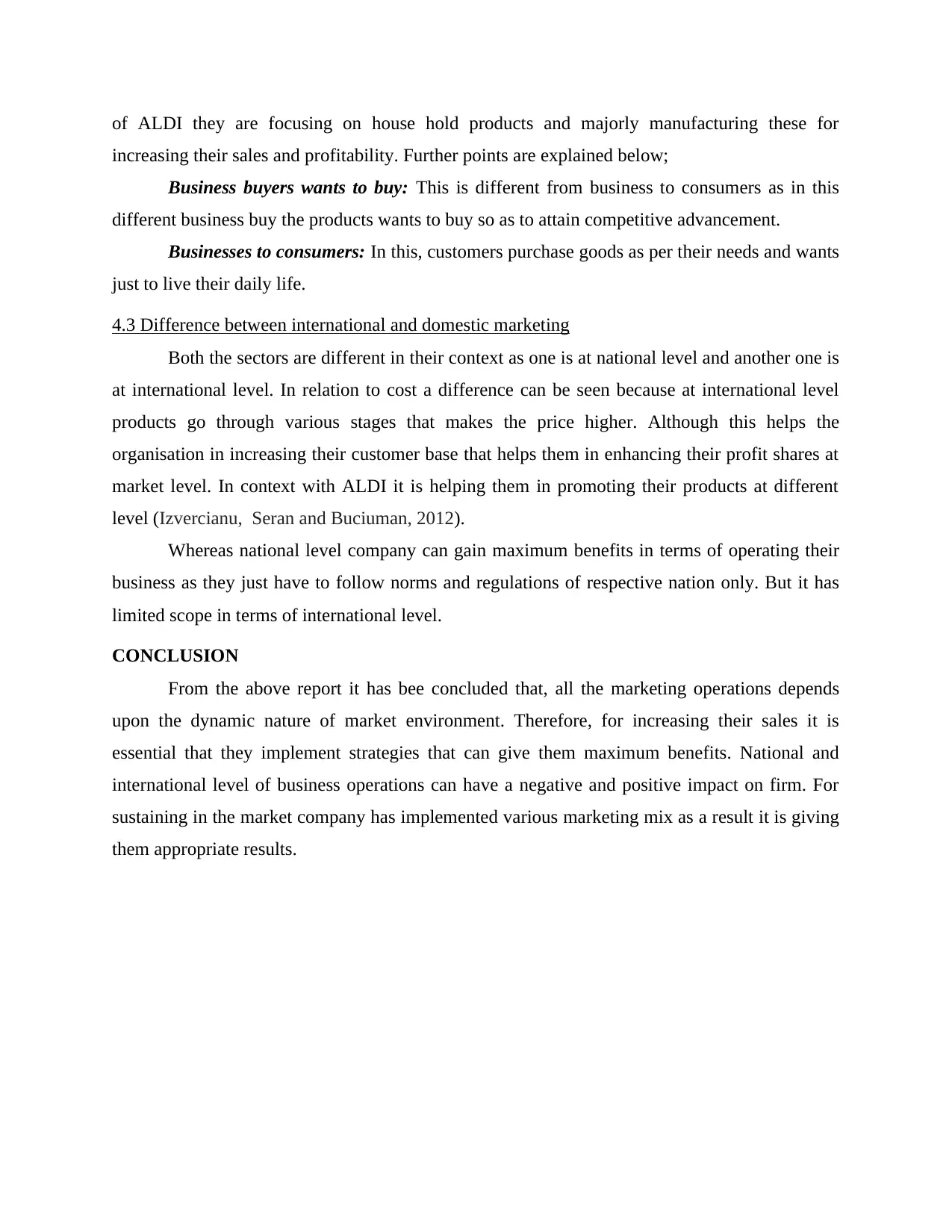
of ALDI they are focusing on house hold products and majorly manufacturing these for
increasing their sales and profitability. Further points are explained below;
Business buyers wants to buy: This is different from business to consumers as in this
different business buy the products wants to buy so as to attain competitive advancement.
Businesses to consumers: In this, customers purchase goods as per their needs and wants
just to live their daily life.
4.3 Difference between international and domestic marketing
Both the sectors are different in their context as one is at national level and another one is
at international level. In relation to cost a difference can be seen because at international level
products go through various stages that makes the price higher. Although this helps the
organisation in increasing their customer base that helps them in enhancing their profit shares at
market level. In context with ALDI it is helping them in promoting their products at different
level (Izvercianu, Seran and Buciuman, 2012).
Whereas national level company can gain maximum benefits in terms of operating their
business as they just have to follow norms and regulations of respective nation only. But it has
limited scope in terms of international level.
CONCLUSION
From the above report it has bee concluded that, all the marketing operations depends
upon the dynamic nature of market environment. Therefore, for increasing their sales it is
essential that they implement strategies that can give them maximum benefits. National and
international level of business operations can have a negative and positive impact on firm. For
sustaining in the market company has implemented various marketing mix as a result it is giving
them appropriate results.
increasing their sales and profitability. Further points are explained below;
Business buyers wants to buy: This is different from business to consumers as in this
different business buy the products wants to buy so as to attain competitive advancement.
Businesses to consumers: In this, customers purchase goods as per their needs and wants
just to live their daily life.
4.3 Difference between international and domestic marketing
Both the sectors are different in their context as one is at national level and another one is
at international level. In relation to cost a difference can be seen because at international level
products go through various stages that makes the price higher. Although this helps the
organisation in increasing their customer base that helps them in enhancing their profit shares at
market level. In context with ALDI it is helping them in promoting their products at different
level (Izvercianu, Seran and Buciuman, 2012).
Whereas national level company can gain maximum benefits in terms of operating their
business as they just have to follow norms and regulations of respective nation only. But it has
limited scope in terms of international level.
CONCLUSION
From the above report it has bee concluded that, all the marketing operations depends
upon the dynamic nature of market environment. Therefore, for increasing their sales it is
essential that they implement strategies that can give them maximum benefits. National and
international level of business operations can have a negative and positive impact on firm. For
sustaining in the market company has implemented various marketing mix as a result it is giving
them appropriate results.
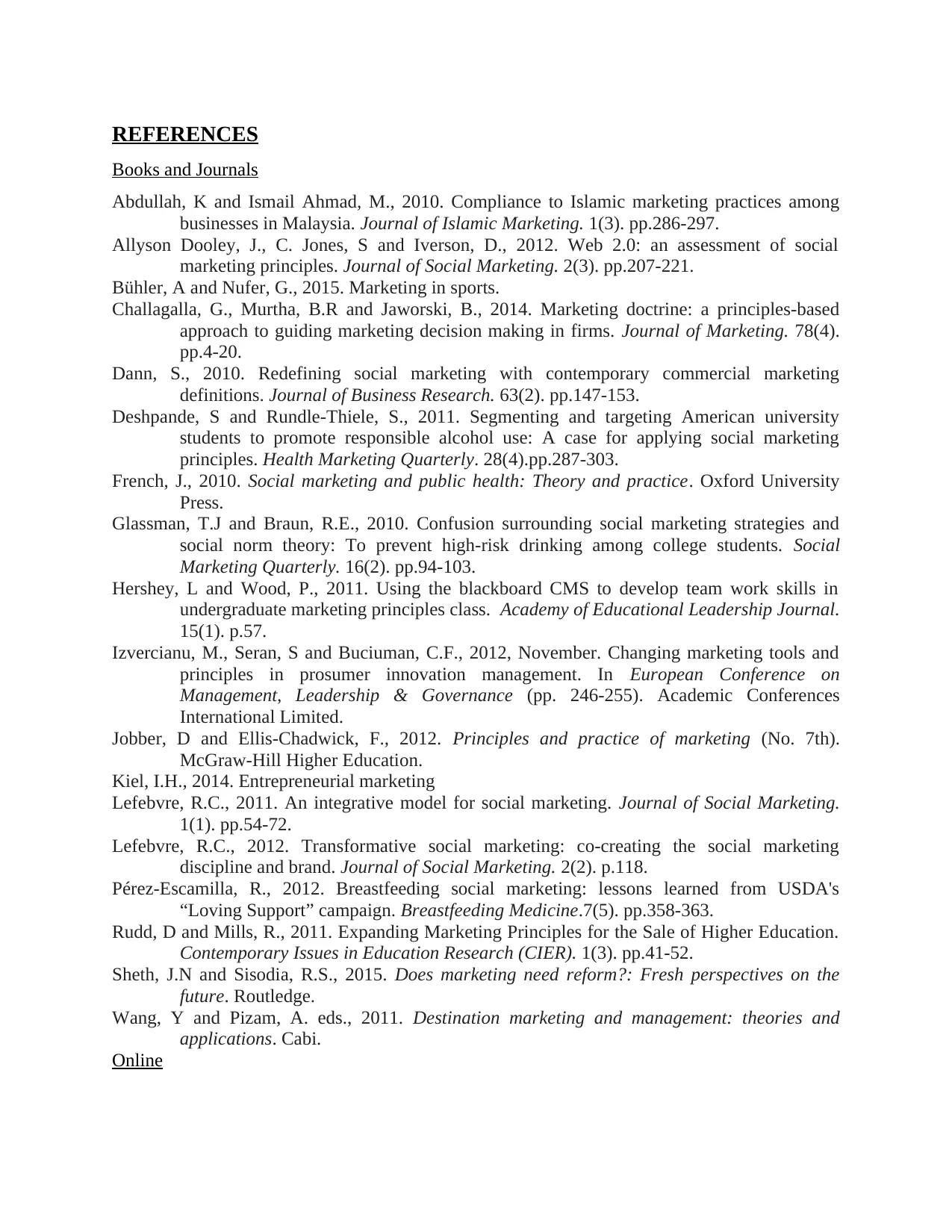
REFERENCES
Books and Journals
Abdullah, K and Ismail Ahmad, M., 2010. Compliance to Islamic marketing practices among
businesses in Malaysia. Journal of Islamic Marketing. 1(3). pp.286-297.
Allyson Dooley, J., C. Jones, S and Iverson, D., 2012. Web 2.0: an assessment of social
marketing principles. Journal of Social Marketing. 2(3). pp.207-221.
Bühler, A and Nufer, G., 2015. Marketing in sports.
Challagalla, G., Murtha, B.R and Jaworski, B., 2014. Marketing doctrine: a principles-based
approach to guiding marketing decision making in firms. Journal of Marketing. 78(4).
pp.4-20.
Dann, S., 2010. Redefining social marketing with contemporary commercial marketing
definitions. Journal of Business Research. 63(2). pp.147-153.
Deshpande, S and Rundle-Thiele, S., 2011. Segmenting and targeting American university
students to promote responsible alcohol use: A case for applying social marketing
principles. Health Marketing Quarterly. 28(4).pp.287-303.
French, J., 2010. Social marketing and public health: Theory and practice. Oxford University
Press.
Glassman, T.J and Braun, R.E., 2010. Confusion surrounding social marketing strategies and
social norm theory: To prevent high-risk drinking among college students. Social
Marketing Quarterly. 16(2). pp.94-103.
Hershey, L and Wood, P., 2011. Using the blackboard CMS to develop team work skills in
undergraduate marketing principles class. Academy of Educational Leadership Journal.
15(1). p.57.
Izvercianu, M., Seran, S and Buciuman, C.F., 2012, November. Changing marketing tools and
principles in prosumer innovation management. In European Conference on
Management, Leadership & Governance (pp. 246-255). Academic Conferences
International Limited.
Jobber, D and Ellis-Chadwick, F., 2012. Principles and practice of marketing (No. 7th).
McGraw-Hill Higher Education.
Kiel, I.H., 2014. Entrepreneurial marketing
Lefebvre, R.C., 2011. An integrative model for social marketing. Journal of Social Marketing.
1(1). pp.54-72.
Lefebvre, R.C., 2012. Transformative social marketing: co-creating the social marketing
discipline and brand. Journal of Social Marketing. 2(2). p.118.
Pérez-Escamilla, R., 2012. Breastfeeding social marketing: lessons learned from USDA's
“Loving Support” campaign. Breastfeeding Medicine.7(5). pp.358-363.
Rudd, D and Mills, R., 2011. Expanding Marketing Principles for the Sale of Higher Education.
Contemporary Issues in Education Research (CIER). 1(3). pp.41-52.
Sheth, J.N and Sisodia, R.S., 2015. Does marketing need reform?: Fresh perspectives on the
future. Routledge.
Wang, Y and Pizam, A. eds., 2011. Destination marketing and management: theories and
applications. Cabi.
Online
Books and Journals
Abdullah, K and Ismail Ahmad, M., 2010. Compliance to Islamic marketing practices among
businesses in Malaysia. Journal of Islamic Marketing. 1(3). pp.286-297.
Allyson Dooley, J., C. Jones, S and Iverson, D., 2012. Web 2.0: an assessment of social
marketing principles. Journal of Social Marketing. 2(3). pp.207-221.
Bühler, A and Nufer, G., 2015. Marketing in sports.
Challagalla, G., Murtha, B.R and Jaworski, B., 2014. Marketing doctrine: a principles-based
approach to guiding marketing decision making in firms. Journal of Marketing. 78(4).
pp.4-20.
Dann, S., 2010. Redefining social marketing with contemporary commercial marketing
definitions. Journal of Business Research. 63(2). pp.147-153.
Deshpande, S and Rundle-Thiele, S., 2011. Segmenting and targeting American university
students to promote responsible alcohol use: A case for applying social marketing
principles. Health Marketing Quarterly. 28(4).pp.287-303.
French, J., 2010. Social marketing and public health: Theory and practice. Oxford University
Press.
Glassman, T.J and Braun, R.E., 2010. Confusion surrounding social marketing strategies and
social norm theory: To prevent high-risk drinking among college students. Social
Marketing Quarterly. 16(2). pp.94-103.
Hershey, L and Wood, P., 2011. Using the blackboard CMS to develop team work skills in
undergraduate marketing principles class. Academy of Educational Leadership Journal.
15(1). p.57.
Izvercianu, M., Seran, S and Buciuman, C.F., 2012, November. Changing marketing tools and
principles in prosumer innovation management. In European Conference on
Management, Leadership & Governance (pp. 246-255). Academic Conferences
International Limited.
Jobber, D and Ellis-Chadwick, F., 2012. Principles and practice of marketing (No. 7th).
McGraw-Hill Higher Education.
Kiel, I.H., 2014. Entrepreneurial marketing
Lefebvre, R.C., 2011. An integrative model for social marketing. Journal of Social Marketing.
1(1). pp.54-72.
Lefebvre, R.C., 2012. Transformative social marketing: co-creating the social marketing
discipline and brand. Journal of Social Marketing. 2(2). p.118.
Pérez-Escamilla, R., 2012. Breastfeeding social marketing: lessons learned from USDA's
“Loving Support” campaign. Breastfeeding Medicine.7(5). pp.358-363.
Rudd, D and Mills, R., 2011. Expanding Marketing Principles for the Sale of Higher Education.
Contemporary Issues in Education Research (CIER). 1(3). pp.41-52.
Sheth, J.N and Sisodia, R.S., 2015. Does marketing need reform?: Fresh perspectives on the
future. Routledge.
Wang, Y and Pizam, A. eds., 2011. Destination marketing and management: theories and
applications. Cabi.
Online
⊘ This is a preview!⊘
Do you want full access?
Subscribe today to unlock all pages.

Trusted by 1+ million students worldwide
1 out of 14
Related Documents
Your All-in-One AI-Powered Toolkit for Academic Success.
+13062052269
info@desklib.com
Available 24*7 on WhatsApp / Email
![[object Object]](/_next/static/media/star-bottom.7253800d.svg)
Unlock your academic potential
Copyright © 2020–2025 A2Z Services. All Rights Reserved. Developed and managed by ZUCOL.




![Marketing Principles: A Case Study on ALDI (UK) - [Course Code]](/_next/image/?url=https%3A%2F%2Fdesklib.com%2Fmedia%2Fimages%2Ftw%2Fb396d4bd6b394a72841d1ce45968ac0c.jpg&w=256&q=75)
